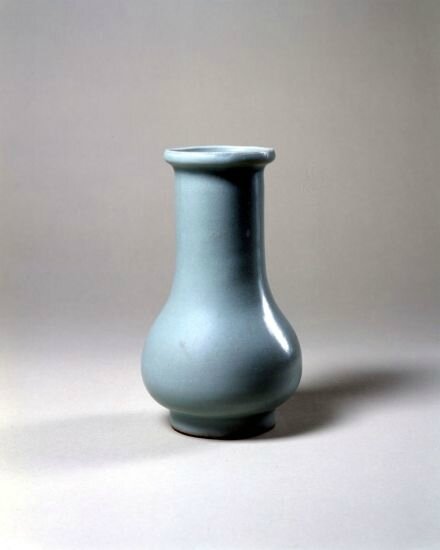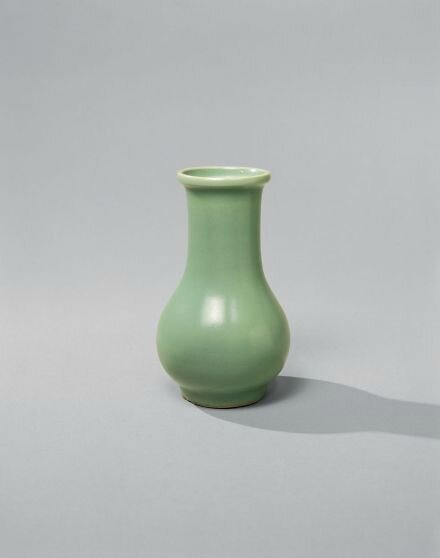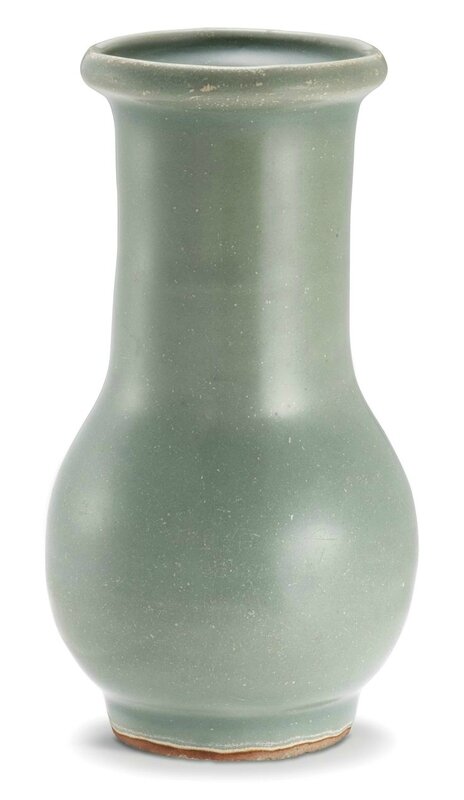A 'Longquan' celadon vase, Southern Song dynasty (1127–1279)
Lot 523. A 'Longquan' celadon vase, Southern Song dynasty (1127–1279). Estimate 50,000 — 70,000 HKD. Lot sold 325,000 HKD. Photo Sotheby's.
the pear-shaped body rising from a short tapered foot to a tall cylindrical neck and upturned everted rim, covered overall with a soft sea-green glaze thinning at the rim and stopping neatly at the foot, the unglazed foot rim burnt to a light orange in the firing - 14.5 cm, 5 3/4 in.
Note: A vase of this type, from the collections of Mrs Alfred Clarke and Edward T. Chow, was sold in our London rooms, 16th December 1980, lot 299, and is illustrated in Regina Krahl, Chinese Ceramics from the Meiyintang Collection, vol. 1, London, 1994, pl. 555; one, from the Carl Kempe collection and now in the Museum of far Eastern Antiquities, Stockholm, is published in Oriental Ceramics. The World’s Great Collections, 1982, vol. 8, pl. 146; and another in the Musée Guimet, Paris, is illustrated Terre de Neige, de Glace, et d’Ombre, Taipei, 1999, pl. 33.
Sotheby's. Chinese Art, Hong Kong, 02 Dec 2016
NDB: See also:
A Longquan celadon vase, Southern Song dynasty (A.D. 1127-1279) in 'Chinese Ceramics A.D. 400–1400: Selections from an American Collection', March 19 - 31, 2007 at J. J. Lally & Co Oriental Art.
with pear-shaped body and wide cylindrical neck rising to a shallow flared mouth with galleried lip, covered inside and out with a light bluish-green glaze of even tone, thinning to a slightly paler hue at the lip and pooling to a deeper bluish color inside the mouth, the glaze continuing over the flat base recessed within a high ring foot, the thin edge of the foot unglazed and the surface of the stoneware showing a dark purplish gray color. Height 6 1⁄4 inches (15.9 cm)
Published: Mowry, ‘Chinese Ceramics from the Collection of Dr. and Mrs. Marvin L. Gordon,’ Orientations, March 2004, fig. 5, p. 118
A similar Longquan celadon vase excavated in 1963 from the tomb of Ren Xi Qing, dated A.D. 1213, discovered at Wuhan, Hebei province and now in the collection of the Hubei Provincial Museum, is illustrated in Kaogu, 1964, no. 5, pp. 237-240; the same vase is illustrated in Longquan Yao Qingci (Celadons from Longquan Kilns), Taipei, 1998, no. 109, p. 142.
Compare also the two similar Longquan celadon vases illustrated by Krahl, Chinese Ceramics from the Meiyingtang Collection, Vol. One, London, 1994, nos. 554 and 555, p. 296, both from the Collections of Mrs. Alfred Clark and Edward T. Chow, where the author discusses the dark color of the exposed edge of the thin footrim of no. 554, caused by the application of an iron-rich wash to simulate the darker body of guanwares. The present example shows the same characteristics.
Another Longquan celadon vase of this form in the Musée Guimet, Paris, from the Michel Calmann Collection, was exhibited at the National History Museum in Taipei and illustrated in the catalogue entitled Terre de Neige, de Glace, et d’Ombre: Quatorze siècles d’histoire de la ceramique chinoise à travers les collections du Musée Guimet, Taipei, 1999, no. 33; and a similar vase is illustrated by Gyllensvärd, Chinese Ceramics in the Carl Kempe Collection, Stockholm, 1964, no. 96, p. 50.
A Longquan celadon vase, Southern Song dynasty (A.D. 1127-1279) in 'The Gordon Collection: Chinese Ceramics and Works of Art', March 12 - April 4, 2009 at J. J. Lally & Co Oriental Art.
of pear shape with steeply sloping shoulders rising to a wide cylindrical neck and wide mouth with rounded, galleried rim, standing on a slightly tapered ring foot, the glaze of attractive bluish-green color showing an even tone all over, draining to a paler hue at the lip rim and pooling to a more intense color inside the mouth, the unglazed edge of the footrim burnt to a pale russet tone in the firing. Height 5 7⁄8 inches (15 cm).
Published: Mowry, ‘Chinese Ceramics from the Collection of Dr. and Mrs. Marvin L. Gordon,’ Orientations, March 2004, fig. 5, p. 118
A similar Longquan celadon vase excavated in 1963 from the tomb of Ren Xi Qing, dated A.D. 1213, discovered at Wuhan, Hebei province and now in the collection of the Hubei Provincial Museum, is illustrated in Kaogu, 1964, no. 5, pp. 237-240; the same vase is illustrated in Longquan Yao Qingci (Celadons from Longquan Kilns), Taipei, 1998, no. 109, p. 142.
Compare also the Longquan vase of this form in the Meiyintang Collection, formerly in the Collections of Edward Chow and Mrs. Alfred Clark, illustrated by Krahl in Chinese Ceramics from the Meiyintang Collection, Volume One, London, 1994, no. 555, p. 296. Another Longquan vase of this form in the Musée Guimet, from the Michel Calmann Collection, was exhibited at the National History Museum in Taipei in 1999 and illustrated in the catalogue entitled Terre de Neige, de Glace, et d’Ombre, no. 33; and the same vase was previously illustrated in the exhibition catalogue Collection Michel Calmann, Musée Guimet, 1969, no. 13, p. 47. Similar vases in the Kempe Collection are illustrated by Gyllensvard in Chinese Ceramics in the Carl Kempe Collection, Stockholm, 1964, nos. 96 and 97, p. 50.
A Longquan' celadon vase, Southern Song Dynasty. Estimate 150,000 — 200,000 HKD (16,995 - 22,660 EUR). Unsold at Sotheby's Hong Kong, 03 déc. 2015, Lot 241. Photo Sotheby's.
Cf. A Longquan' celadon vase, Southern Song Dynasty
A 'Longquan' celadon vase, Southern Song Dynasty. Sold 93,750 USD at New York, 16 Mar 2016, Lot 251. Photo: Sotheby's.

/https%3A%2F%2Fprofilepics.canalblog.com%2Fprofilepics%2F1%2F0%2F100183.jpg)
/https%3A%2F%2Fstorage.canalblog.com%2F03%2F02%2F119589%2F96711876_o.jpg)
/https%3A%2F%2Fstorage.canalblog.com%2F11%2F31%2F119589%2F94773502_o.jpg)
/https%3A%2F%2Fstorage.canalblog.com%2F20%2F83%2F119589%2F94772815_o.jpg)
/https%3A%2F%2Fstorage.canalblog.com%2F26%2F72%2F119589%2F75604929_o.jpg)
/https%3A%2F%2Fstorage.canalblog.com%2F59%2F60%2F119589%2F26458628_o.jpg)







/http%3A%2F%2Fstorage.canalblog.com%2F31%2F69%2F119589%2F127204726_o.jpg)
/http%3A%2F%2Fstorage.canalblog.com%2F79%2F17%2F119589%2F126962276_o.jpg)
/http%3A%2F%2Fstorage.canalblog.com%2F49%2F06%2F119589%2F126956351_o.jpg)
/http%3A%2F%2Fstorage.canalblog.com%2F82%2F28%2F119589%2F126954842_o.jpg)